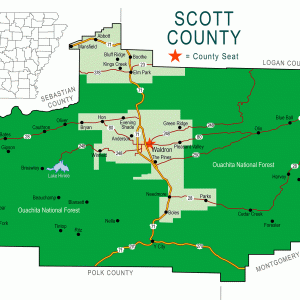calsfoundation@cals.org
Needmore (Scott County)
The community of Needmore is located along Highway 71 in south-central Scott County. Never officially incorporated as a town, the community stretches from the top of a large hill, known as Needmore Hill, to the hill’s base. Buffalo Creek and the Fourche La Fave River are within a few miles of Needmore.
The area where Needmore is now located was once a wilderness inhabited by natives of the Archaic, Woodland, and Mississippian periods. Prior to European exploration, the Caddo tribe lived along the Fourche River Valley. Burial mounds and other archaeological sites can be found along the Fourche La Fave River near Needmore.
During the late seventeenth and early eighteenth centuries, French trappers and traders traveled west from Arkansas Post, eventually making it to the area that would become Scott County. These Frenchmen likely traversed the Fourche La Fave River near Needmore.
Settlers began arriving in the area where Needmore is located prior to the Civil War. As the towns of Boles (Scott County) and Parks (Scott County) grew, people began settling in the Needmore area, which is located between the two towns. The Needmore Cemetery was established circa 1866, though it was originally known by another name. The cemetery was established by J. C. and Adeline Brown. Their first child, Joe Riley, was reportedly the first burial in the cemetery. The cemetery is located near the intersection of Highways 28 and 71.
Until around 1926, there were no businesses or religious establishments in the area now known as Needmore. That year, John Walls built a ten-by-twenty-foot building east of Highway 71 and south of Highway 28 and began selling necessities to residents. Sometime later, Pat Murphy began managing the store. Murphy stocked a limited supply of groceries, like most small stores in the county. When a customer would come into the store asking for something Murphy did not have, he would often reply by saying, “I need more of that.” This became a running joke with members of the community. Customers would intentionally ask for items he did not have in order to keep the joke running. People in the community began calling the store Needmore, and eventually the community was known by the same name.
Pearly Bass and Chaney Stroud built a larger store across Highway 28 from the Murphy store. During this time, Highway 71 was being paved, thus bringing more people to Needmore. Oliver Calvert and his wife, Eula Calvert, built a third store in the northeast corner of the intersection of Highway 71 and Highway 28. A small café was located beside the Calvert store for a several years. In 1936, an Assembly of God Church was organized in Needmore. The church building is located at the bottom of Needmore Hill near the junction of the highways.
Throughout the mid-1900s, ownership of the Needmore stores changed several times. After World War II, Will and Mary Lovett bought the Calvert store and the Bass-Stroud store. The Calverts moved to California after selling their store. Will Lovett constructed a larger rock-veneer store in place of the original Bass-Stroud store; the new store also contained living quarters. Will Lovett built another store in 1950 that was located west of Highway 71. This store was later closed, and the building used as a residence. After a few years, Will Lovett sold the Bass-Stroud store to Garland and Lillie May Laird. It was then sold to Valton and Lois Holleman in 1949. The Hollemans kept the store until 1958. That year, the Hollemans sold the store to Charlie and Dorothy Jameson. The last people to own the Bass-Stroud store were Ed and Bennie Hutchens. The Hutchenses managed the store until they constructed a new building farther up Needmore Hill to the north. They operated an automotive repair service out of half of the building, while a store was leased to Joe Ed Scott in the other half. The store was named “Scott’s on the Hill.”
A grist mill was owned and operated at the top of Needmore Hill by Tom Nichols in the 1940s. A café operated by George and Nancy Lutomsky was located north of the mill. The café burned down sometime after 1959.
The rock-veneer store built by Lovett was torn down in 1988. The Hutchens store building was eventually sold again and renamed “Needmore Grocery and Station.” The store supplied some food items along with gas and automotive services. This was the last business in operation within the Needmore community until it burned in the early 2010s. In the early 1990s, the Ouachita Mountain Missionary Baptist Church was built at the top of Needmore Hill. The Assembly of God was eventually closed and began being used as a place of residence.
For additional information:
Cate, Michael. History of Scott County, Arkansas. Dallas, TX: Curtis Media Corporation, 1991.
Echoes: The Scott County Historical and Genealogical Society Quarterly. Waldron, AR: Scott County Historical and Genealogical Society (1986–).
Goodner, Charles. Scott County in Retrospect. Mansfield, AR: Frank Boyd, 1976.
Goodner, Norman. A History of Scott County, Arkansas. Siloam Springs, AR: Bar D Press, 1941.
McCutcheon, Henry Grady. History of Scott County, Arkansas. Little Rock: H. G. Pugh and Company, 1922.
Ty Richardson
Richardson Preservation Consulting
 Scott County Map
Scott County Map 



Comments
No comments on this entry yet.